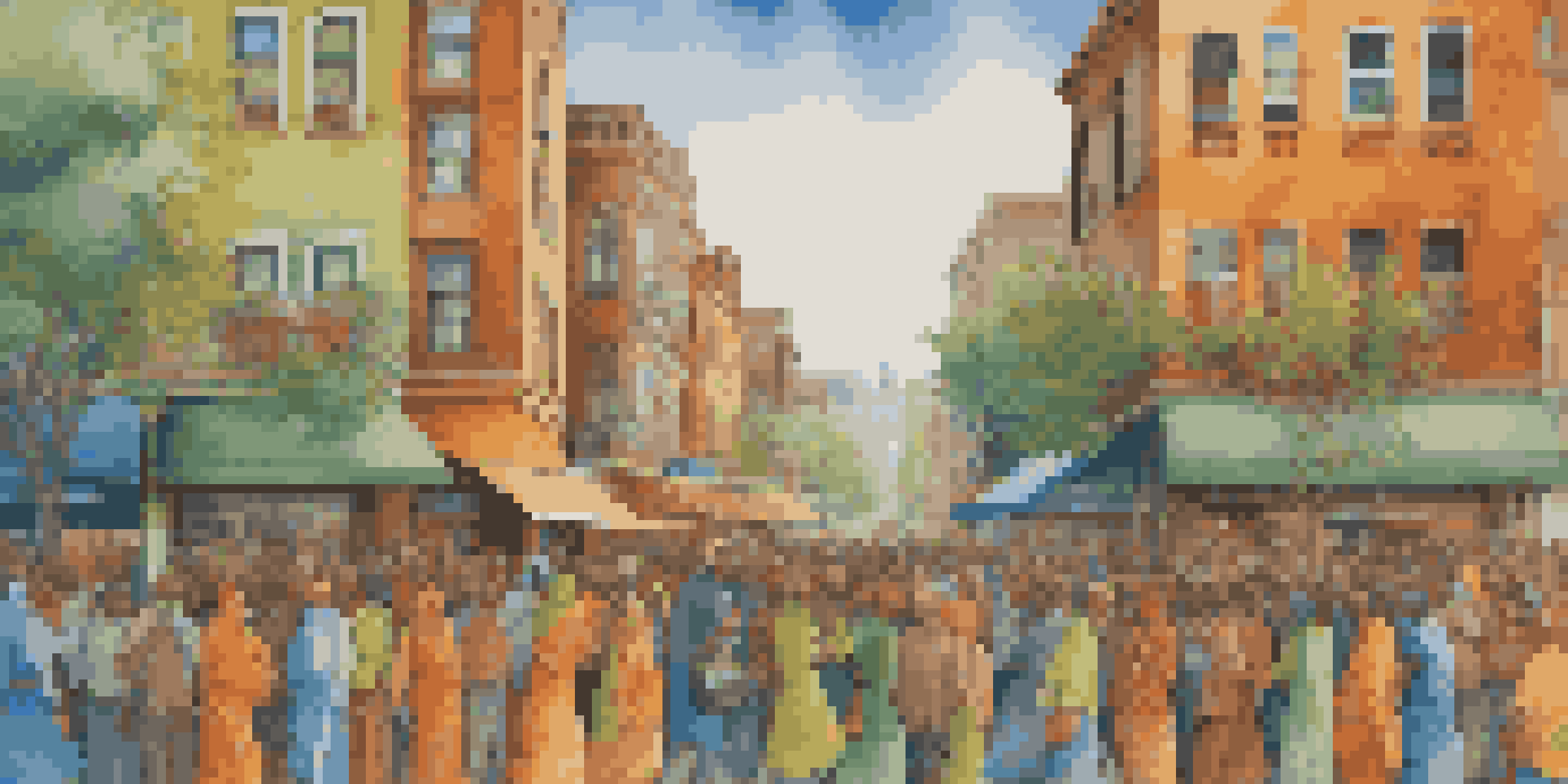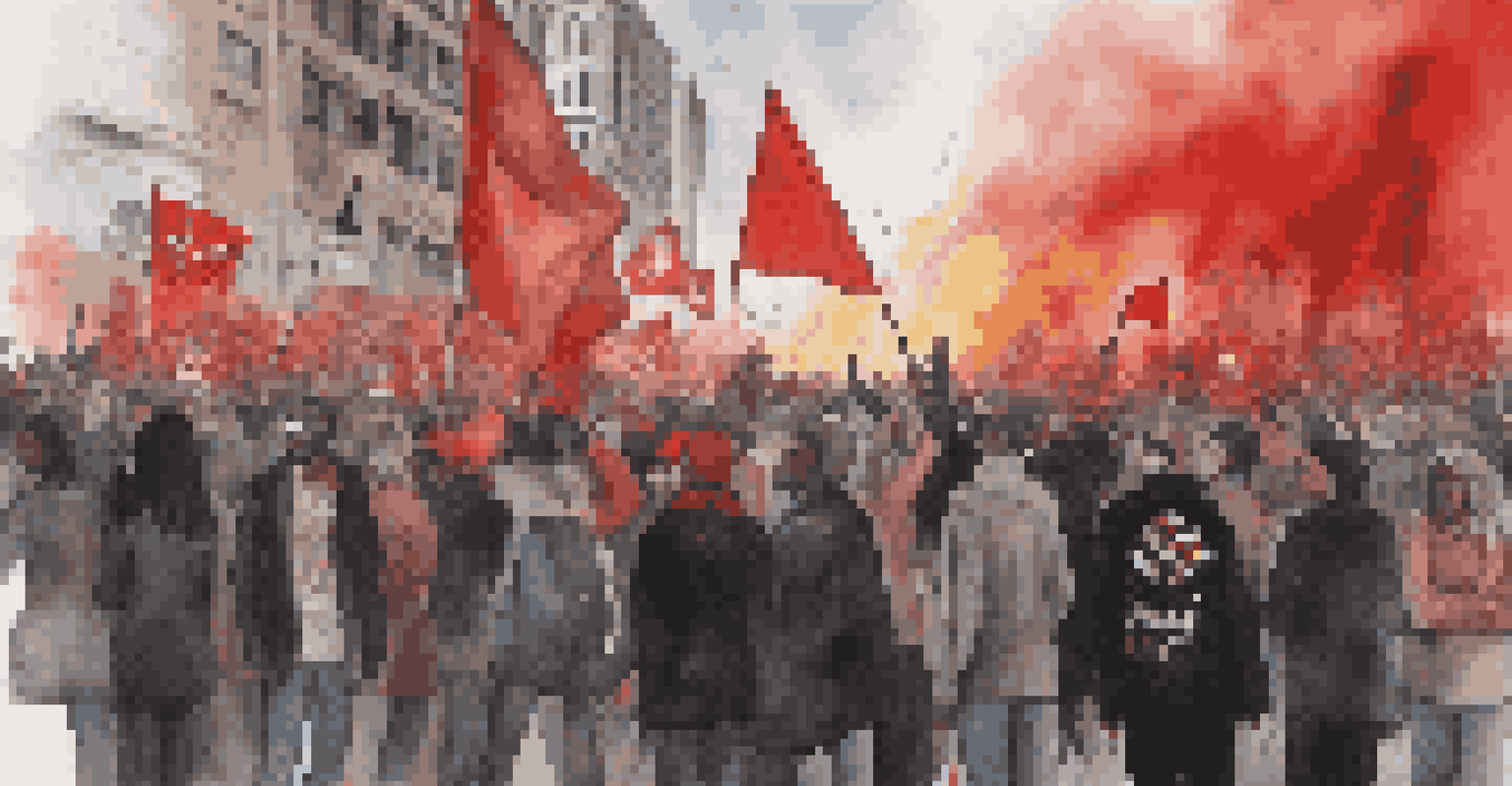The Role of Art in Shaping Public Narratives and Memory

Understanding the Concept of Public Narratives
Public narratives are the stories that societies tell themselves about their past, present, and future. These narratives help shape collective identity and influence how communities perceive their shared history. Art plays a crucial role in crafting these narratives, providing a medium through which stories can be expressed and shared.
Art is not freedom from discipline, but disciplined freedom.
From paintings to performances, art captures emotions and experiences that resonate with the public. This ability to evoke feelings makes art a powerful tool in shaping narratives, as it can highlight specific themes or events that might otherwise be overlooked. By engaging audiences emotionally, art ensures that these narratives are not only heard but felt.
Moreover, public narratives are often shaped by dominant cultural perspectives, and art can challenge or reinforce these views. Artists have the power to question societal norms and provoke thought, encouraging audiences to reconsider their understanding of history and identity. Through this dialogue, art contributes to a more nuanced and diverse public narrative.
Art as a Reflection of Collective Memory
Collective memory refers to how groups remember their past and the events that shape their identity. Art serves as a mirror, reflecting these memories and allowing societies to process their experiences. Whether through murals depicting historical events or films showcasing personal stories, art captures the essence of collective memory.

For instance, community murals often depict significant historical events or figures, fostering a sense of belonging and shared identity among residents. These visual representations can reignite interest in local history, helping communities connect with their past. Art thus becomes a vessel for preserving and celebrating collective memory.
Art Shapes Public Identity
Public narratives are influenced by art, which captures emotions and experiences that resonate with communities, helping to shape their collective identity.
Additionally, art can also act as a catalyst for healing in communities affected by trauma. By expressing painful memories through creative outlets, artists and their audiences can confront difficult histories together. This healing process not only preserves memory but also encourages dialogue around shared experiences.
The Role of Art in Activism and Social Change
Art has long been a powerful vehicle for activism, serving to raise awareness and inspire action. Artists often use their work to address social issues, creating pieces that challenge the status quo and encourage public discourse. This intersection of art and activism plays a vital role in shaping narratives around pressing societal concerns.
The artist is nothing without the gift, but the gift is nothing without work.
For example, protest art can powerfully convey messages about inequality, injustice, and change. By transforming personal experiences into relatable visuals or performances, artists can mobilize communities and foster a sense of urgency. This ability to connect with audiences on an emotional level enhances the impact of their message.
Moreover, social media has amplified the reach of activist art, allowing for a broader audience to engage with these narratives. Digital platforms enable artists to share their work instantly, facilitating a global conversation about important issues. Through this interconnectedness, art can unify voices and inspire collective action for social change.
Art in Commemorating Historical Events
Commemoration through art plays a critical role in how societies remember significant events. Monuments, public installations, and commemorative performances serve as reminders of history, allowing communities to reflect on their past. These artistic expressions can evoke a sense of reverence and provoke critical discussions about the implications of these events.
For instance, memorials dedicated to tragic events often serve as spaces for reflection and mourning. They not only honor those lost but also encourage visitors to engage with the history behind the memorial. Art transforms personal grief into a collective experience, fostering empathy and understanding.
Art as a Tool for Activism
Artists use their work to address social issues and inspire action, making art a powerful vehicle for activism and societal change.
Additionally, the artistic representation of historical events can shape how future generations perceive their past. By embedding narratives in art, societies can pass down stories that might otherwise fade from memory. This continuity ensures that important lessons from history remain relevant and impactful.
The Transformative Power of Storytelling in Art
Storytelling is a fundamental aspect of human experience, and art provides a unique medium for conveying these stories. Through various forms of artistic expression, such as literature, theater, and visual arts, narratives can be shared in ways that resonate deeply with audiences. This connection between storytelling and art enhances the impact of public narratives.
For example, a powerful novel can shed light on historical injustices, prompting readers to empathize with characters and their struggles. Similarly, theater productions can bring to life pivotal moments in history, making them accessible and engaging for diverse audiences. Art thus serves as a bridge between past and present, allowing stories to be told in compelling ways.
Furthermore, the act of storytelling through art can empower marginalized voices. Artists often use their platforms to share experiences that challenge dominant narratives, fostering inclusivity and understanding. This democratization of storytelling not only enriches the public narrative but also encourages a broader range of perspectives.
The Impact of Digital Art on Public Narratives
In today's digital age, art has transcended traditional boundaries, evolving into new forms that shape public narratives. Digital art, including graphic design, social media campaigns, and interactive installations, allows for innovative storytelling methods. This evolution has expanded the ways in which narratives can be crafted and disseminated.
For instance, digital platforms enable artists to reach global audiences, amplifying their messages and narratives. Online campaigns can quickly mobilize support for social issues, demonstrating the power of art in the digital realm. This accessibility fosters a more inclusive dialogue around public narratives, allowing diverse voices to be heard.
Digital Art Expands Narratives
In the digital age, new forms of art allow for innovative storytelling, reaching global audiences and fostering inclusive dialogues around public narratives.
Moreover, interactive digital art invites audiences to engage actively with the narrative, creating a sense of participation and ownership. This engagement can deepen the connection between the audience and the story, leading to a more profound understanding of the issues at hand. As technology continues to evolve, so will the ways in which art shapes our public narratives.
The Future of Art in Shaping Public Narratives
As society continues to evolve, so too does the role of art in shaping public narratives. Emerging technologies, such as virtual reality and augmented reality, present exciting opportunities for artists to create immersive experiences that engage audiences in new ways. These innovations can deepen emotional connections and foster a richer understanding of complex narratives.
Additionally, the growing emphasis on social justice and equality has prompted many artists to address these themes in their work. This shift reflects a collective desire for change and the recognition of art's role in challenging societal norms. As artists continue to respond to contemporary issues, public narratives will inevitably evolve.

Ultimately, the future of art in shaping public narratives lies in collaboration and inclusivity. By working together across disciplines and communities, artists can create multifaceted narratives that reflect a diverse range of experiences. This collaborative approach will not only enrich public discourse but also ensure that art remains a vital force in shaping our shared understanding of the world.